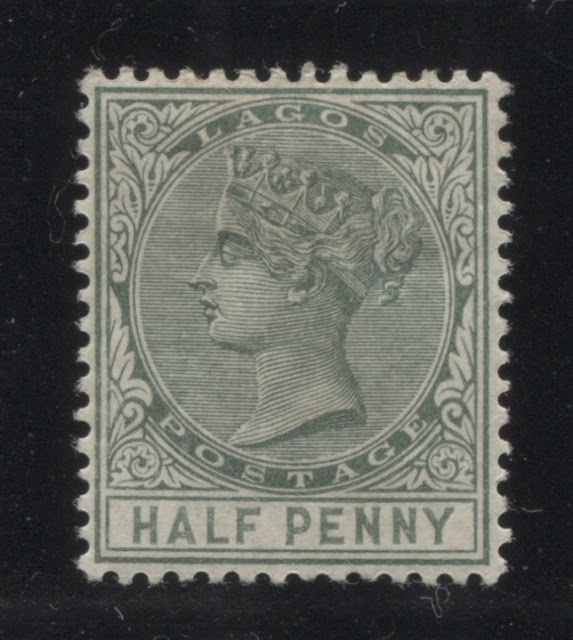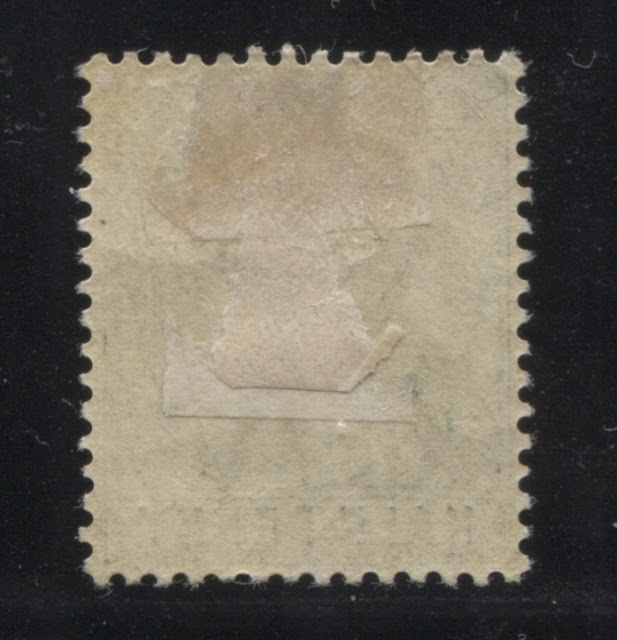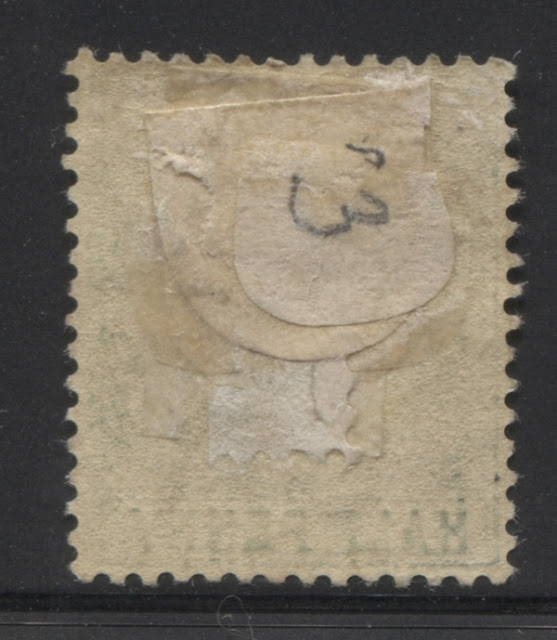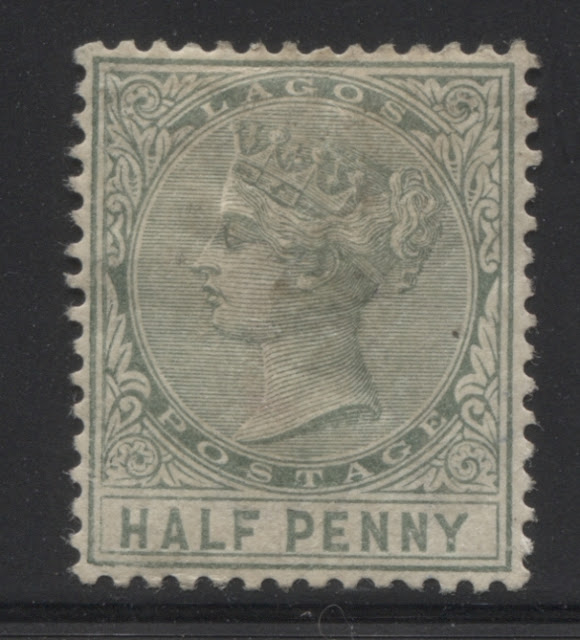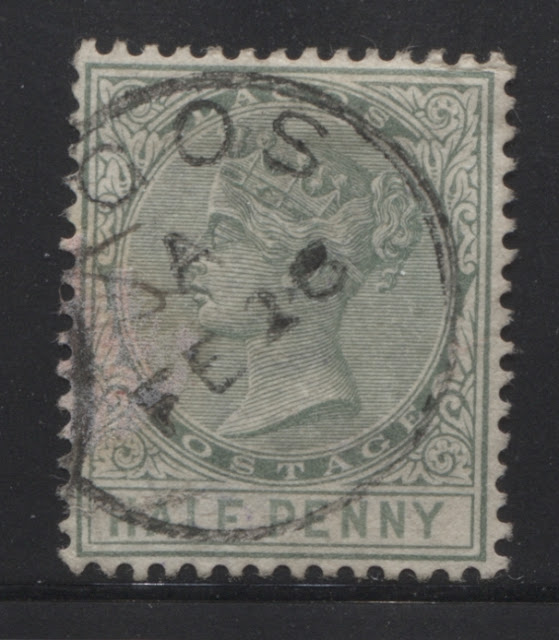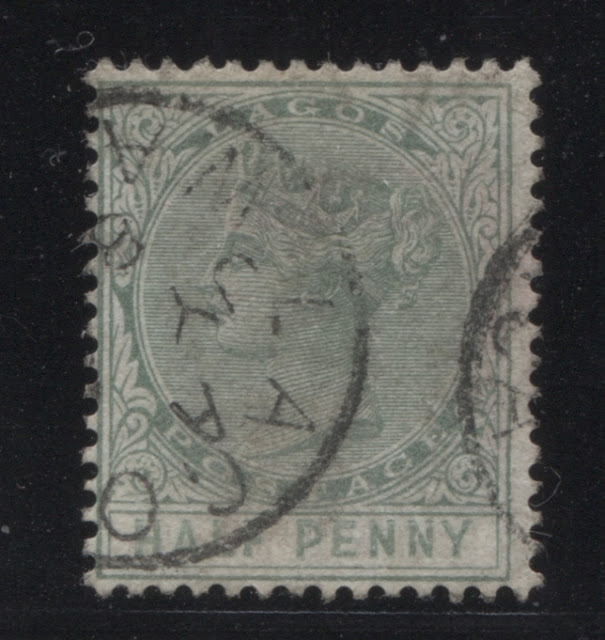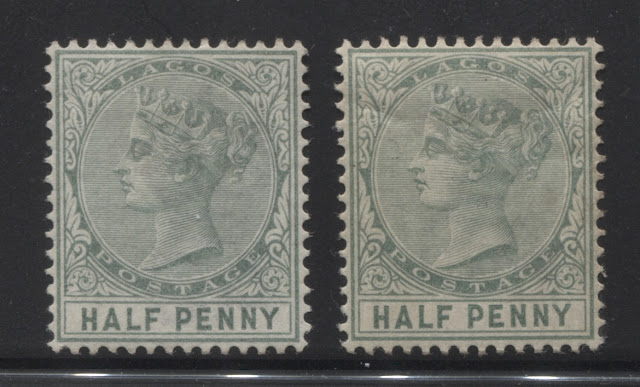Today's post begins the long and arduous journey into the printings of the two most complicated stamps of the Queen Victoria period for the colony of Lagos: the halfpenny green and 1d carmine surface printed stamps, with the crown CA watermark. The halfpenny was a new denomination, whose genesis was the invention of the post-card and the subsequent reduction in postage rates for this new and quick form of communication. The 1d carmine replaced the earlier 1d mauve and both stamps continued in use throughout the remainder of Queen Victoria's reign - a little more than 16 years. Given that the Crown Agents were supplying stamps to Lagos on a quarterly basis, or almost quarterly, this meant a very large number of printings:
- There were a staggering 42 printings of the halfpenny stamp made between 1885 and 1902.
- There were 49 printings of the 1d carmine made between 1884 and 1902.
Identifying these, or as many of them as possible is the task of the next series of posts. In tackling this daunting task, the starting point is to divide the period into three sub-periods, which can then be broken down further and tackled separately:
- The period before 1887, when the earlier colour changes were issued.
- The period from 1887 to 1900 when plate 1 continued to be used.
- The period from 1900-1902 when plate 2 was in use.
The plate 2 stamps should be easy to identify by the clarity of the printing, and the colours, given that their immediate predecessors will have been printed from the most worn state of plate 1, and will not be nearly as fine, but should be in similar shades to those from plate 2. They should also be relatively easy to identify from the fact that the plate markings were different, most cancellations at this time are dated and they make up the bulk of the mint copies on the market today.
The stamps issued before 1887 should also be identifiable from characteristics of the other denominations that were printed during this time that we are familiar with, now that we have studied them:
- Any stamp cancelled with an 8-bar oval killer will likely be from before 1887.
- Any mint stamp that either has no gum, brownish gum or crackly gum is likely to be from the period before 1887.
- The last three printings before 1887 will have the later double gum and these will be more difficult to identify with certainty.
The trickiest period will of course be the middle period from 1887 to 1900, when the bulk of the printings were made. Here, the progression of shades, dated cancellations and the progression of plate wear will all give important clues into how the printings should be ordered. All other things being equal, the 9-bar oval cancelled examples should probably be first, followed by the later Lagos CDS cancels.
Today's post will attempt to identify and describe the printings of the halfpenny green that fall into this brief period from 1885-1887. There were six printings totaling 24,300 stamps. This was roughly 2% of the total printing of halfpenny stamps. So needless to say, these stamps are relatively scarce. However, I have been fortunate to have a very large number of mint an used stamps at my disposal to study. Over a year ago, I sorted them into what I felt were all the different printings. I identified 75 different groupings - way more than there were printings. So while I most likely do have all 42 printings, it is clear that at least 32 of my groupings would have to be combined with one another in coming up with 42 final groups.
Today's post will examine those stamps that I believe may have come from the first six printings, which were made as follows:
- First Printing - November 24, 1885 - 60 sheets, or 3,600 stamps.
- Second Printing - December 29, 1885 - 62 sheets or 3,720 stamps.
- Third printing - March 29, 1886 - 61 sheets or 3,660 stamps.
- Fourth printing - June 30, 1886 - 60 sheets or 3,600 stamps.
- Fifth printing - October 12, 1886 - 80 sheets, or 4,800 stamps.
- Sixth printing - December 13, 1886 - 82 sheets, or 4,920 stamps.
The first characteristics I am looking for among the stamps that I have sorted are:
- Any dated CDS cancel prior to 1887.
- Any 8-bar oval killer cancel.
- Any mint stamp that has brownish single gum.
- Any mint stamp having crackly or slightly crackly gum.
The rest of the post describes the stamps that I have found that seem to possess the above characteristics.
Stamp 1
The first stamp that I came across that might fit in this period, I have included here purely on account of the gum. The gum is a deep cream, but is very slightly crackly in appearance, as are several of the 1885 printings of other values. The stamp is heavily hinged, with 19th century hinge remnants, which is another sign of it being from an earlier printing.
Here is the back scan of that stamp:
In terms of colour, the head plate is a deep grey-green, while the duty plate is a pure grey-green. This is a bit duller than I have been led to believe that the colour is supposed to be for a stamp of this period, but the plate displays a level of wear that is consistent with the period. Here is the front scan of this stamp:
Here is the back scan of that stamp:
As you can see in the scan, most of the details of the hair and diadem are still visible, though there is some merging of the lines at the top of the hair and the back of the head. That is similar to the level of wear seen on the other values printed from plate 1 at this time.
However, it is very possible that this is merely one of the earliest printings from the 1887-1900 period. The final verdict as to whether this belongs in the period will depend on what other stamps I uncover that possess one of the characteristics discussed in the beginning of this post.
Stamp 2
The next stamp was also selected because of the gum, which was visibly crackly without the aid of a loupe. Again, it is a very heavily mounted stamp, with large paper hinge remnants, which tends to support it's classification as an early printing. Here is what the back of that stamp looks like:
On this scan you can clearly see the crackliness of the gum, which is an almost sure sign that it cannot be from the 1887-1900 period.
The colour of both the head plate and the duty plate is dull green. The hair and diadem shows most of the detail with the merging of lines at the top of the hair and the back of the head that would be expected for a stamp of this period. Here is what the front of this stamp looks like:
Not a fresh stamp by any stretch of the imagination. All the characteristics stronly support the notion that this is truly one of those first 6 printings.
Stamp Three
The next stamp is the first used example that I came across that I thought could be properly attributed to this period. I chose it this time on the basis of the cancellation, which although not complete, is clearly an 8-bar oval killer. I can tell that it is an 8-bar killer because the two middle bars are of even length. Both the head plate and duty plate are a grey green, that is not much different from the above second stamp:
The detail of the hair and diadem is very clear on this one without any merging of the shading lines. This tends to suggest that it is one of the earlier printings out of the six.
Stamp Four
This next stamp was chosen because it was canceled with an early example of the Lagos CDS cancels, although this particular cancel had no year date unfortunately. So there is some chance that it could be an early printing from the 1887-1900 period, though it is most likely from this period.
Here is a front scan:
The colour of head plate is a dull green, while the duty plate is a pale dull green. There is a very mild amount of plate wear apparent from the slight merging of some of the shading lines in the hair. This is consistent with it's classification as a printing of this period.
Stamp Five
The next stamp may well not belong to this period, as I do not have a full date visible on the cancellation. All I know is that it is dated before 1890. The colour on this one is completely different from the other stamps - a pale dull yellowish green, which is similar to the shade described by Ince in his work about the stamps of this issue, that he associates with the first printings. The only factor that does not support its inclusion in this period is the degree of plate wear that is evident in the design:
Stamps Six Through Eight
The next three stamps I chose because of the colour, which is a pale dull bluish green for both the head and duty plates, and because the stamps showed the very mild degree of plate wear associated with this period. The gum on the mint stamp is the colourless double gum that likely places it as one of the last three printings. The two used examples are cancelled with postmarks that tend not to be found on the later printings. One of these is a straight-line Iddo postmark, and the other one is another early Lagos CDS whose details are not legible.
Here are the scans of the mint stamp:
As you can see, this is not much different from stamp number five above. Here is the back scan:
As the scan shows, this is the smooth, double gum of the post April 1886 printings.
Here are the two used examples:
The shades very closely match the mint stamp, and both stamps show the mild plate wear that is associated with the stamps of this period.
Stamps Nine and Ten
The next two stamps were chosen because of the similarity between their shade and the above three stamps, because the plate wear is consistent with the early period and because one of the stamps has the smooth brownish single gum that is associated with the printings made in late 1885 and early 1886. The other stamp has no gum. Here are the stamps as seen from the front:
The head plate of these stamps is a dull green, while the duty plate is a deep dull green. Here is the back scan:
That brownish, coffee coloured smooth gum is completely consistent with a printing made between late 1885 and April 1886.
Stamp Eleven
This last stamp I chose both because of the gum, which was brownish, and because the colour is a unlike any of the other printings, although it is reasonably close to the first stamp that I chose. The design shows just a touch more wear than the other printings, but it could also appear this way due to heavy inking. The head plate is a very deep dull green, while the duty plate is a deep dull green.
Here is the scan of the front:
Note how deep the colour is, without having either any hint of grey, not blue. Now, here is the scan of the back:
This gum although toned is quite thick, and appears to be double gummed. This suggests to me that it is one of the last printings.
Final Conclusions
I managed to identify 11 different stamps that came from 8 different groupings , when I only have 6 printings. So clearly one of these is not one of the first printings, but it is likely one of the first printings of the 1887-1900 period. That leaves one extra stamp, which is likely just a variant of one of the other printings. I believe that stamp five is close enough in shade to stamps six through eight, so as to be from the same printing.
In terms of order, the first printing from November 24, 1885 must be the one that has the crackly gum. That is stamp two. Stamp two is dull green for both the head and the duty plate. If the printings are following a logical progression in terms of shades, then it follows that the second printing from December 29, 1885 should be very similar, with some dull green. Stamp four, with its undated early CDS cancel is dull green and pale dull green. So it would seem to make sense to identify this as the second printing.
The third printing sent on March 29, 1886 just pre-dates the introduction of double gum, so the third printing should be the one printing we have identified that has toned single gum. That would be stamps nine and ten.
The fourth printing that was sent on June 30, 1886 should be a similar shade to the third printing , and so stamps five through eight should be part of this printing.
The fifth and six printings are tricky because the colour completely changes from a pale dull bluish green to a deep dull green and a grey green. I believe now that the first stamp is really the first printing of the 1887-1900 period, and this stamp is deep grey green and grey green. Thus the sixth printing will be the stamp closest in shade to that one, which is stamp two. Thus the fifth printing from October 12, 1886 is stamp eleven, printed in the very deep dull green, with the deep dull green duty plate and the toned double gum.
This is my best attempt at assigning the first six printings of this value. Next week I will attempt to identify the first 11 printings of the 1d. Once this is done, I can begin to tackle the arduous task of sorting the more than 30 printings of each value that fell into the middle period from 1887 through 1900.


